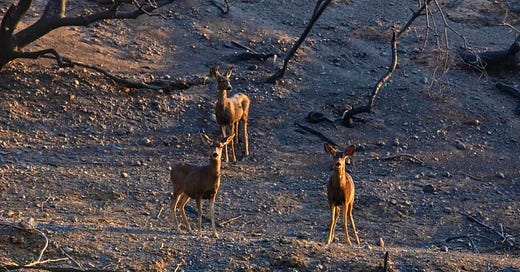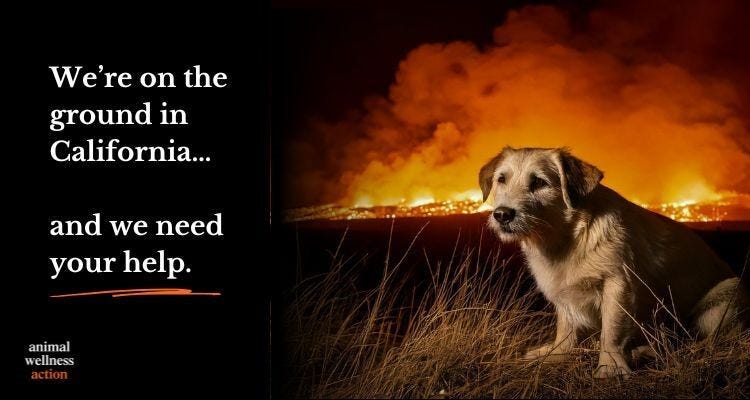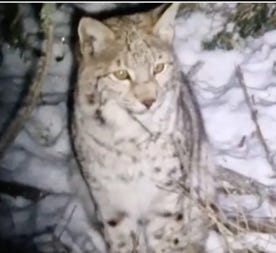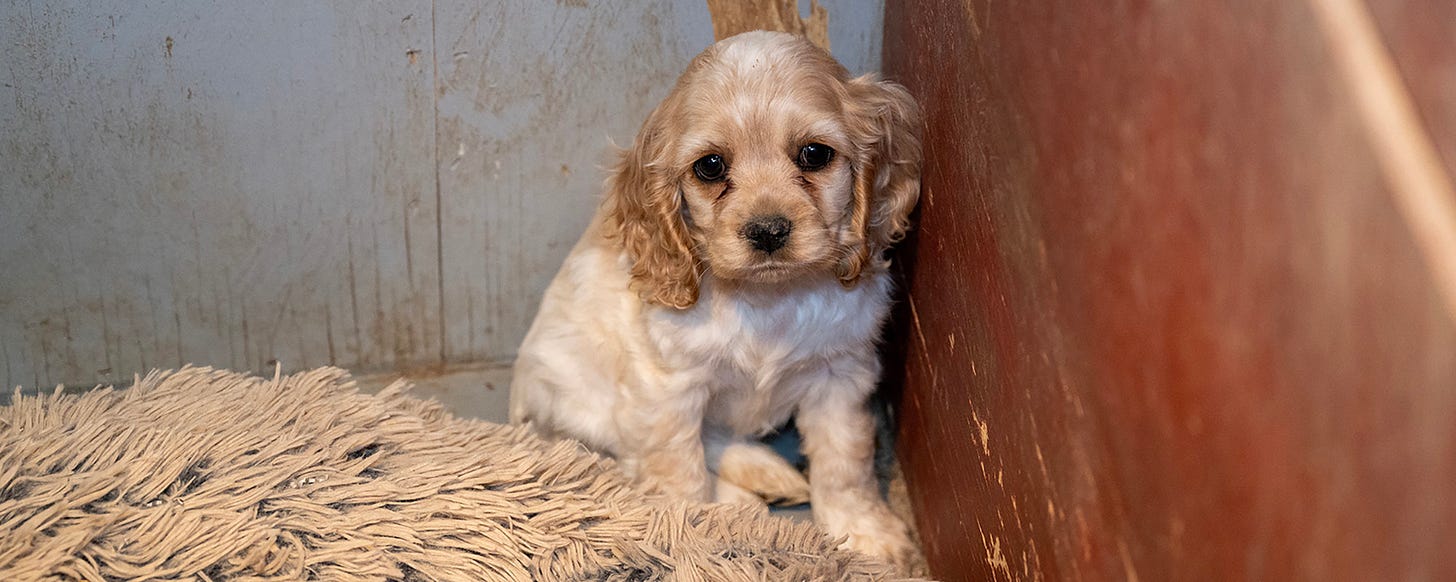Elusive Shrew Caught on Camera; Smallest Monkey Losing Habitat
January 2025 / Conservation, Wildlife News Roundup
This month’s wildlife recap includes information on a few of the organizations that are helping animals impacted by the Los Angeles area wildfires. Please consider supporting with a contribution if you can and/or share this email with others. Thank you.
More than 55,000 acres of residential and commercial areas and wildlands have burned in California this month. Humans and animals have suffered and died. Bobcats, cougars, coyotes, opossums, owls and rabbits need emergency care, as well as dogs and cats. In addition to firefighters who have rescued many animals, numerous organizations are helping wildlife and pets in the impacted areas.
Here are a few groups you might consider supporting in their efforts to aid animals rescued in this disaster:
Alley Cat Allies is assisting in providing emergency care and support to cats and kittens impacted by the Palisades fire, Eaton fire and other ongoing fires. Their Rapid Response Team has been working with local animal advocates and veterinarians to deliver treatment and ongoing care for displaced cats and kittens, bringing in critical supplies, including food, food bowls, oxygen masks and other medical supplies. You can donate here.
Animal Survival International is working with their partner, Wetlands and Wildlife Care Center of Orange County (WWCC), which has been taking in as many animals as they can help. You can donate here.
Best Friends has a location to provide dog and cat food to the community and is working to respond to pleas for help from shelters in the affected areas. You can donate here.
Humane Society of the United States is providing local veterinary clinics and animal welfare organizations with emergency aid to give care to animals suffering from burns, smoke inhalation and other issues, as well as coordinating with local officials to support on-the-ground efforts. You can donate here.
Pasadena Humane is working to assist found animals, including pets, livestock, exotics and wildlife, lost animals and animals left behind in evacuated homes and properties in the Eaton Fire. You can donate here.
Veterinarian and president of the Animal Wellness Foundation Dr. Annie Harvilicz is on the front lines with her team in Los Angeles helping animals and the people who care about them. Donate here.
Wildfires and severe weather may have you thinking about how to best care for animals in the event of emergency. You can read suggestions here from Four Paws on how to create a plan, assemble a kit and manage change in emergencies.
From my January reading … articles of interest.
Elusive Shrew is Photographed
Living in a small, elevated area of the Eastern Sierra Nevada, and mostly underground, the Mount Lyell shrew (Sorex lyelli) is 9 to 10 centimeters long and weighs between 2 and 3 grams. And until recently, the little mammal had not been photographed.
Vishal Subramanyan, 22, along with his friends Prakrit Jain, 20, and Harper Forbes, 22, undertook the project to photograph the elusive animal. They were challenged by 15-degree temperatures and specific needs of the animal. The shrew has an incredibly fast metabolism and will die if it doesn’t eat every two hours, so the young researchers had to monitor the traps frequently.
“The majority of earth’s biodiversity remains unknown,” said Jain. “Projections suggest that most species remain scientifically undescribed, and of the described species, the majority remain unphotographed. Only a tiny fraction has seen any sort of detailed field study.
“This issue persists even in well-studied places like California. In an era of rapid biodiversity loss, it is important to record this information while it still exists while simultaneously fighting the extinction crisis.”
Go here to see pictures of Sorex lyelli.
World’s Smallest Monkey Faces Shrinking Habitat in Ecuador
Adorable, endangered and no bigger than an apple, the world’s smallest monkey, the pygmy marmoset, is endangered.
Pygmy marmosets live in gallery forests that border rivers in the Amazon basin. People are drawn to the gallery forests because of the water. The housing encroachment on the habitat of the pygmy marmoset is worsened by more habitat loss from agriculture and the oil industry.
Read about the pygmy marmoset and see video here.
What’s Not to Love About Prairie Dogs?
While too many people consider prairie dogs pests, they are great ecosystem engineers, digging “ingenious tunnel systems.” And without them, the populations of black-footed ferrets, burrowing owls, ferruginous hawks, mountain plovers and swift foxes would be reduced, as the prairie dog is a food source for them.
Once one of the most abundant animals on the prairie, prairie dogs now occupy just 2 percent of their historic range. They are hated by many in the West, writes High Country News, but some Indian tribes, landholders and researchers are working vigorously to save them.
Read the entire story at High Country News here.
Lynx Found in Scotland
A rogue release of cats is believed to be behind the story of how four lynxes ended up in the Scottish Highlands. All four were caught and showed signs of starvation. Of the four, one died. After being evaluated by veterinarians, the three survivors were moved to a quarantine facility at Edinburgh Zoo and are reportedly doing well under the care of expert keepers and vets.
The Eurasian lynx was an occupant of the Scottish Highlands a thousand years ago. The Highlands were the cat’s last refuge in the British Isles. Several groups are pushing for lynx to be reintroduced to Scotland. However, they are on record saying the release of these cats was “reckless for both the lynx and for their cause.”
Read the Smithsonian Magazine article here and more on the death of the one lynx here.
Good Fences for Ugandan Farmers Make for Good Elephant Neighbors
Elephants are, of course, HUGE animals that humans often don’t think make good neighbors. Across Africa in protected areas, the majority of governments say that human-wildlife conflict is a problem.
In Uganda’s Queen Elizabeth National Park, crop-raiding elephants can destroy farmers’ production. One solution to mitigate the problem is installing electric fences. Farmers may like them, but not everyone does.
Read the Mongabay story here.
Trump’s DOGE Can Eliminate Wasteful Gov’t Spending, Animal Cruelty
“If the President honors his pledge to cut wasteful spending — and he’s created a Department of Government Efficiency (DOGE) to be led by Tesla founder Elon Musk to support the commitment — it could yield major gains since so many forms of animal mistreatment are driven by government and the use of taxpayer dollars,” writes Wayne Pacelle at Animal Wellness Action.
Among programs that could be cut, Pacelle suggests stopping the Biden plan to kill nearly 500,000 forest owls (est. cost $1.35 billion), replacing wild horse roundups with cost-effective fertility control programs (potential savings of $1 billion over 10 years) and ending the federal subsidy for killing wildlife (est. cost savings of $1 billion over 10 years).
Read more here from Pacelle about how government spending can be cut and animal welfare increased.
Contact the New Congress
Please ask the 119th Congress to pass strong animal protection laws. You can use the Humane Society Legislative Fund form here to contact your elected officials.
Maria Fotopoulos writes about the connection between overpopulation and biodiversity loss, and occasionally other topics that confound her.
Buy me a cup of coffee, and you’ll help support wildlife writing! Thank you.
Support wildlife writing when you buy this tee shirt.
Buy it here.
















Outstanding! Please donate to California’s shelter doing so much to comfort homeless pets
Great summary. Thanks for highlighting the Lynx release - that particular incident was irresponsible, but it’s essential to get Lynx back into the landscape in the long term. I’ve written a few posts about that.